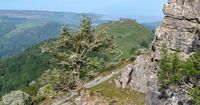On September 15, 2025, the latest chapter in Wales’ long-running debate over national parks began, as Natural Resources Wales (NRW) launched a public consultation on the proposed Glyndwr National Park. If established, Glyndwr would become Wales’ fourth national park, stretching from the windswept coast of Prestatyn in Denbighshire, winding through Flintshire and Wrexham, and reaching into the rolling hills of northern Powys. The proposal has sparked both hope and concern among residents, politicians, and conservationists, with passionate arguments on each side about what the future might hold for this storied landscape.
The idea behind Glyndwr National Park isn’t new, but this latest push comes after two years of detailed evaluation, technical assessments, and extensive community engagement. According to BBC News, the park’s potential boundaries have shifted in response to earlier feedback: part of Powys has now been removed from the proposal, while areas like Gronant and the Talacre Dunes have been reinstated. The park’s southern edge would now run along several miles of the A458 between Llanfair Caereinion and Mallwyd, encompassing Dyfnant Forest and Lake Vyrnwy, before narrowing into a northbound corridor that stretches to the coast between Prestatyn and Talacre.
Natural Resources Wales, commissioned by the Welsh government, is leading the consultation process. Ash Pearce, Programme Manager at NRW, described the proposal as a “once-in-a-generation opportunity to protect nature, support communities, and shape a better future for this stunning part of Wales.” Pearce acknowledged that change can be difficult, but insisted, “with the right approach, a new National Park could bring real benefits for people, wildlife and the local economy.” The public, landowners, and stakeholders are being encouraged to attend events, both in-person and online, to learn more and provide feedback before the consultation closes on December 2, 2025.
Supporters of the park see it as a chance to protect rural areas from overdevelopment, boost recognition for the region, and provide legal safeguards for natural beauty, wildlife, and cultural heritage. According to WalesOnline, a pros and cons document published as part of the consultation highlights that a designated national park would receive more direct funding than an area of outstanding natural beauty. In 2024, the existing three parks received a combined £11 million from the Welsh Government, and the new park would be eligible for similar support. The environmental agency also argues that the park could boost tourism, health, and culture, while offering better use of land within its boundaries.
Martin Murray, a member of the Dee Valley Environmental Network, sees the park as a lifeline for communities that have “stagnated” in recent times. “My own village has no pub anymore, no primary school, and people there are very upset,” he told BBC Radio Wales Breakfast. “I think increased tourism in this wonderful place surely will be a benefit.” Murray also pointed out that a new national park could help ease the burden on Eryri (Snowdonia) during peak times, saying, “It seems sensible to connect the two landscapes and thin out the overcrowding and just generally enhance the Dee Valley all the way along the coast.”
The park’s proposed name, Glyndwr, pays homage to Owain Glyndŵr, the last native Prince of Wales and a legendary figure whose rebellion against English rule began in the northeast. As reported by WalesOnline, a report on the naming explained, “Glyndŵr was from the northeast, and lived at Sycharth, within the boundaries of the park. His surname, Glyndŵr, is a variant form of Glyndyfrdwy, one of the constituent regions of the park, and his rebellion began in the northeast.” The report noted that there has been an “explosion of interest in Glyndŵr” in recent years, suggesting the name would give the park instant recognition and foster local pride. However, it also warned that the association with Welsh independence could lead to accusations of political bias, given the growing prominence of the independence movement in Welsh politics.
Yet, not everyone is convinced that the park is the right answer. An initial public engagement exercise in 2023 found 51% of respondents in favor of the new park, with 42% against. Opponents worry about the impact on local residents, whether roads could handle an influx of visitors, rising house prices, and the potential for more restrictive planning rules. Powys County Councillor Glyn Preston, who is also the Welsh Liberal Democrat candidate for Gwynedd Maldwyn, has been a vocal critic. He argued, “This National Park was proposed as part of a Plaid Labour deal for the Clwydian Hills and that should be its limits. The absolute southern boundary should be the Powys border.” Preston, quoted in the Powys County Times, criticized what he called the “nightmare of red tape and planning development cost” that the park would impose on local councils and communities. “With the council having to find millions to bridge the budget gap, the last thing it needs is more cost in opposing ill-conceived plans for a Park we don’t want and extra planning burdens that our communities can’t need.” He called for NRW to withdraw the proposal and return with one that excludes Powys entirely, or for the Minister to instruct them to do so.
Other critics, like Powys councillor Elwyn Vaughan, have voiced concerns about increased pressure on communities, the impact on house prices, and the region’s proximity to the West Midlands potentially leading to more traffic. Vaughan also questioned the wisdom of introducing a new authority at a time when public money is scarce.
NRW, for its part, insists that the creation of Glyndwr National Park would not affect the funding of the existing three parks—Eryri, Pembrokeshire Coast, and Bannau Brycheiniog (Brecon Beacons)—which together attract more than 12 million visitors a year and generate over £1 billion in spending, according to National Parks UK. Each park has its own authority with the power to make planning decisions, and the Welsh Government has pledged that council areas within the new park would not be financially disadvantaged.
The proposed boundaries of Glyndwr National Park encompass a rich tapestry of landscapes and landmarks, from the heather-clad summit of Moel Famau near Mold, to the iconic Horseshoe Falls in Llangollen, and Thomas Telford’s Pontcysyllte Aqueduct in Wrexham. The area also includes Lake Vyrnwy in Powys, the Berwyn Mountains, and the Dyfnant Forest. The proposal notably follows the path of Glyndwr’s Way, a 135-mile national trail named after Owain Glyndŵr, weaving together centuries of history, natural beauty, and local identity.
As the consultation period unfolds, the debate over Glyndwr National Park is set to intensify. Supporters see an opportunity to protect and promote one of Wales’ most treasured regions, while critics fear the unintended consequences for local communities and economies. With the deadline for public input set for December 2, 2025, all eyes are on the Welsh government and NRW to see whether this ambitious vision will become reality—or remain just another chapter in the ongoing story of Wales’ relationship with its wild and beautiful places.
Whatever the outcome, one thing is certain: the future of north-east Wales and Powys is being shaped right now, with every voice and every viewpoint playing a part in deciding what comes next for Glyndwr National Park.




